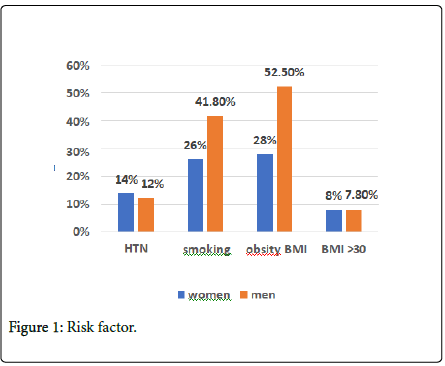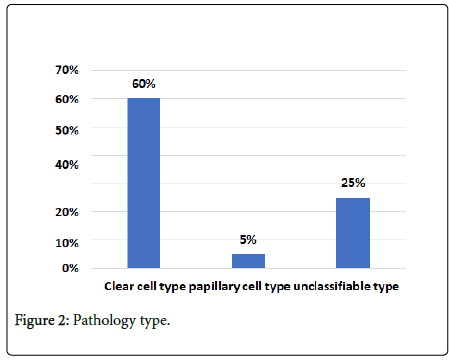Research Article, J Nephrol Ren Dis Vol: 4 Issue: 1
A Retrospective Study of Body Mass Index, Cigarette Smoking and Hypertension, was the Danger of Renal Cell Carcinoma (Yemen)
Abdulbast Darwish, Ezaldean AL Shibany, Hael Saeed, Duyazen Alhosam, Abdullah Ghamdhan, Abdualmlk AL Mekhlafy and Ali Ahmed Al-Zaazaai*
Department of Cardiology, College of Medicine, Sana'a University, Republic of Yemen
*Corresponding Author : Al-Zaazaai AA
Department of Cardiology, College of
Medicine, Sana'a University, Republic of Yemen
Tel: +967771207965
E-mail: alzaazaiali@yahoo.com
Received date: April 07, 2020; Accepted date: April 14, 2020; Published date: April 24, 2020
Citation: Darwish A, Shibany EAL, Saeed H, Alhosam D, Ghamdhan A, et al (2020) A Retrospective Study of Body Mass Index, Cigarette Smoking and Hypertension, was the Danger of Renal Cell Carcinoma (Yemen). J Nephrol Ren Dis 4:1.
Abstract
Aim: We respectively examined the independent relationship of hypertension, body mass index, and cigarette smoking with the danger of renal cell carcinoma in the middle of males and females.
Methods: The recorded of 30 patients who underwent radical nephrectomy between February 2018 to September 2019.
Results: In a retrospective study (file of patients) the average age was 43.4 years. In women 14% described a history of hypertension, 26% were smokers and BMI was 25 kg/m2 in 28.0% and 30 kg/m2 in 8.1% of the patients. In males 12% described a history of hypertension, 41.8% were smokers and the BMI was 25 kg/m2 in 52.5% and 30 kg/m2 in 7.8% of the patients. We confirmed the diagnosis of renal cell carcinoma in 16 females and 14 males alternatively, our pathology the common of cases were defined as strong cell carcinoma (60%), papillary cell carcinoma (15%) and unclassified (25%).
Conclusion: Identification of hypertension, developed BMI and increasing pack-years of cigarette smoking perform to independently grow the danger of renal cell carcinoma and also renal cell carcinoma more communal in females because of hypertension and obesity more in the females.
Keywords: Renal cell carcinoma; Body Mass Index (BMI); Smoking; Hypertension
Introduction
Renal cell carcinoma is the seventh primary reason for cancer, accounting for 3% of malignancy in men Body Mass Index (BMI) and smoking is accepted danger factors for Renal Cell Carcinoma (RCC). Hypertension and antihypertensive drugs have also been concerned. On the other hand, the independent influence of each factor is not well-defined. Although several studies have described these as individual danger factors in univariate analyses, rarer have estimated the independent link of each risk factor in multivariate analyses [1,2]. Raised Body Mass Index (BMI) has reliably been originating to be a danger factor for RCC in females but fewer so in males [3-7]. Cigarette smoking has been reliably identified as a danger factor for RCC in males, but not in females [8].
In the one prospective study that involved males and females, the comparative risk between cigarette smokers was significantly elevated for males, but then not for females. Hypertension has been irregularly related to the danger of RCC [9,10], by some studies finding a relationship only among females and others only between males. The danger of RCC in users of thiazide diuretics remains uncertain [3]. Given that comparatively insufficient studies have been conducted with retrospective data and occurrence cases of RCC in the middle of both males and females, we required to control if our cohorts could contribute to the accepting of the apparent sex discrepancy between the previously informed danger factors. We also require9d examining the independent link of hypertension with RCC, as it is powerfully related to obesity. Consequently, we studied the link between hypertension, BMI, weight change, and cigarette smoking and the danger of RCC.
Materials and Method
Thirty patients (16 females and 14 males, mean age 43.4 years) with renal cell carcinoma were included in this study in the Department of Urology in EZ Alden AL-Shibany Hospital in Sana'a city. The study was conducted between Feb 2018 to Sept 2019 renal cell carcinoma was the diagnosis on basis of clinical, Imaging methods (U/S, CT) information on elevation was gained from the baseline Questionnaire. While weight was checked in our department. The participant was tested to report physician-diagnosed hypertension. Information on smoking Initiation, cessation and number of cigarettes smoked was queried at baseline. This study was executed in retrospective design and all patients provided written informed consent.
Statistical analysis
Multivariate analysis was the patient to investigate independent predicted factors for renal cell carcinoma. Chi-square Test and the fisher’s exact test were used for the difference between the categorical variable the data were analyzed using the statistical package for social sciences version 18. (SPSS 18) p-value of fewer than 0.05 was considered statistically significant.
Results
The present study involves 30 patients’ the mean age was 43.4 years (16 women and 14 men) we confirmed the diagnosis of renal cell carcinoma. In women, 14% reported a History of hypertension 26% were a smoker. The BMI was 25 kg/m2 is 28% of contributors and >30 kg/m2 is 8.1% (Table 1 and Figure 1). 12% of men with a history of hypertension 41.8% of men were smoker, the BMI was 25 kg/m2 is 52.5% of the participants and >30 kg/m2 is 7.8%.
| Risk factor | Women | Men |
|---|---|---|
| HTN | 14% | 12% |
| Smoking | 26% | 41.80% |
| Obesity BMI >25 | 28% | 52.50% |
| BMI >30 | 8% | 7.80% |
Table 1: Shows the danger factor for women and men.
Our pathology the popular of cases were defined as clear cell type 60% papillary cell type is 5%, unclassifiable type 25% (Table 2 and Figure 2).
| Pathology Type | |
|---|---|
| Clear cell type | 60% |
| Papillary cell type | 5% |
| Unclassifiable type | 25% |
Table 2: Shows pathology type for clear, papillary and unclassifiable type.
Discussion
There is insufficient information on hypertension, obesity, and cigarette smoking as a danger factor for RCC and the value of retrospective data such as the recent study [11]. The previous reports have recommended that the danger related to BMI, cigarette smoking and hypertension have different magnitudes between males and females [12]. Our data is reliable with that probability; however, the numeral of cases involved in our study was too small to mate conclusive assessments across sex. In our study, BMI was related to significantly increased danger in females whereas, a non-significant risk was observed in males 41.8%. On the other hand, cigarette smoking was linked with danger in males, even though, nonsignificant links with females. Hypertension was independently related to significantly increased danger of RCC in both females and males [13]. Although, in our study, hypertension was more common in women so the risk of RCC more in women than men. The previous report has implicated and hypertension medication as a causal agent in the carcinogenesis of the prevalence of hypertension individuals in particular thiazide diuretics have been supposedly related to as increased danger of RCC [14]. In the present study, we did not have complete information in construction on dose and duration of thiazide therapy nine to thirteen and the mechanism by which hypertension influences production an accused role in RCC is poorly understood.
Conclusion
This study found that hypertension was related to an increase in renal cell carcinoma in men and women. BMI was related to significantly increased danger only in women and cigarette smoking was increased danger only in men. The growing occurrence of RCC was done, in part, to increase in the prevalence of these modifiable danger factors, the mechanism by which these factors in flounce the growth of RCC need additional study.
Authors’ Contribution
Dr. Abdulbast Darwish, Ezaldean AL Shibany, Hael Saeed, Duyazen ALhosam, Abdullah Ghamdhan, and Abdualmlk AL Mekhlafy; study concept and design, data acquisition, interpretation; manuscript drafting, study supervision, the idea of the manuscript, collection, analysis, writing and literature review. Dr. Ali Ahmed Al-Zaazaai: revision of the manuscript for important intellectual content, and publication.
Conflict of Interests
The authors declared that there were no conflicts of interests arising in the process of this study.
Funding
This research received a specific grant from Dr. Abdulbast Darwish, Ezaldean AL Shibany.
References
- Yuan JM, Castelao JE, Gago-Dominguez M, Yu MC, Ross RK (1998) Tobacco use in relation to renal cell carcinoma. Cancer Epidemiol Biomarkers Prev 7: 429-433.
- Mellem Gaard A, Niwa S, Mehl ES, Engholm G, McLaughlin JK, et al. (1994) Risk factors for renal cell carcinoma in Denmark: Role of medication and medical history. Int J Epidemiol 23: 923-930.
- Hiaatt AH, Tolan K, Quesen Berry CPJ (1994) Renal cell carcinoma and thiazide use: a historical, case-control study (California, USA). Cancer Causes Control 5: 319-325.
- Chow WH, Mclaughlin JK, Mandel JS, Wacholder S, Niwa S, et al. (1996) Obesity and risk of renal cell cancer. Cancer Epidemiol Biomarkers Prev 5: 17-21.
- Heath CWJ, Lally CA, Calle EE, McLaughlin JK, Thun MJ (1997) Hypertension, diuretics, and antihypertensive medications as possible risk factors for renal cell cancer. Am J Epidemiol 145: 607-613.
- Whittemore AS, Paffenbarger RSJ, Anderson K, Lee JE (1985) Early precursors of site-specific cancers in college men and women. J Natl Cancer Inst 74: 43-51.
- Asal NR, Risser DR, Kadamani S, Geyer JR, Lee ET, et al. (1988) Risk factors in renal cell carcinoma. Cancer Detect Prev 11: 359-377.
- La Vecchia C, Negri E, D’Avanzo B, Franceschi S (1990) Smoking and renal cell carcinoma. Cancer Res 50: 5231-5233.
- Weinmann S, Glass AG, Weiss NS, Psaty BM, Siscovick DS, et al. (1994) Use of diuretics and other antihypertensive medications in relation to the risk of renal cell cancer. Am J Epidemiol 140: 792-804.
- Muscat JE, Hoffman D, Wynder EL (1995) The epidemiology of renal cell carcinoma. Cancer 75: 2552-2557.
- Tian Shen, Xiao-Ou Shu, Yong-Bing Xiang, Li HL, Cai H, et al. (2015) Association of hypertension and obesity with renal cell carcinoma risk: A report from the Shanghai men’s and women’s health studies. Cancer Causes Control 26: 1173-1180.
- Censin JC, Peters SAE, Bovijn J, Ferreira T, Pulit SL, et al. (2019) Causal relationships between obesity and the leading causes of death in women and men. PLoS Genet 15: e1008405.
- Weikert S, Boeing H, Pischon T, Weikert C, Olsen A, et al. (2008) Blood pressure and risk of renal cell carcinoma in the European prospective Investigation into cancer and nutrition. Am J Epidemiol 167: 438-446.
- Keith TF, Charles SF, Colditz GA, Stampfer MJ, Speizer FE, et al. (2005) A prospective study of body mass index, hypertension, and smoking and the risk of renal cell carcinoma (United States). Cancer Causes Control 16: 1099-1106.
 Spanish
Spanish  Chinese
Chinese  Russian
Russian  German
German  French
French  Japanese
Japanese  Portuguese
Portuguese  Hindi
Hindi 


